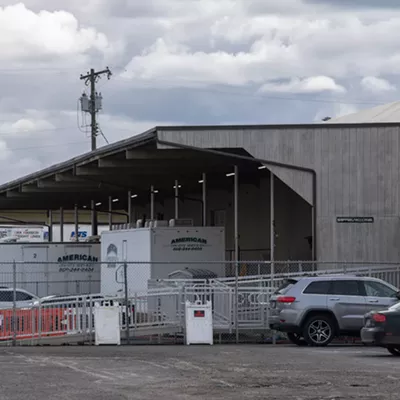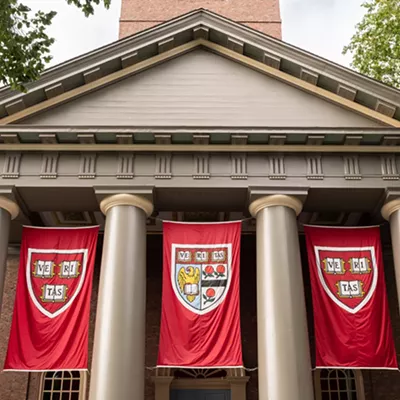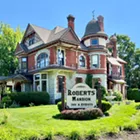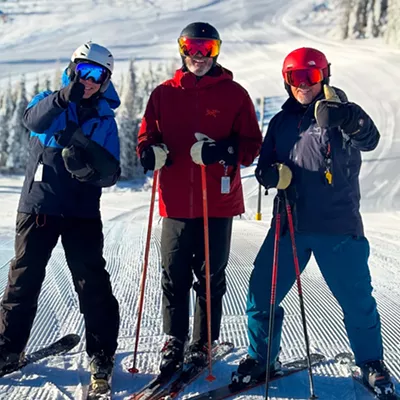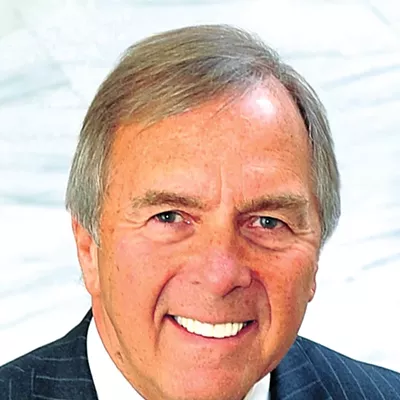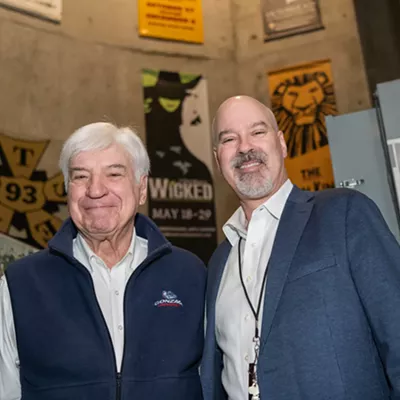If you're planning ahead to provide your biographer with colorful anecdotes, the sure-fire way to earn fame and fortune is to leave home on the day you graduate from high school. In Marshall Chesrown's case, he even threw in a couple of you-can't-make-this-stuff-up flourishes. How did he get there? On a motorcycle. What did he bring with him? A saxophone.
Bing Crosby pulled a similar trick back in 1924 (although not on his graduation day; he was 22) in a broken-down jalopy, on a borrowed tank of gas and with not much more than his golf clubs in the trunk.
Of course, in both cases, it's what came next that made that first step the stuff of local legend. But for Chesrown, that journey has come full circle; seven years ago, he returned to his home town. Armed with what appears to be a golden touch — and plenty of cash — the latest chapter in Chesrown's story involves pushing Spokane and the Inland Northwest out of that big small town twilight zone it has lingered in since he left it in his rear-view mirror on May 8, 1976. With his Black Rock development on Lake Coeur d'Alene and now Kendall Yards in downtown Spokane, Marshall Chesrown may be a human tipping point.
"We've been discovered," Chesrown says of the Inland Northwest, 30 years after he left it for San Diego. The comment sounds how old Bing would have come off if he'd have said, "You know, this jazz singing thing has really taken off." Like he had nothing to do with it.
Starting Out
For Chesrown at age 18, it was all about music. After a typical Spokane Valley childhood — riding horses and shooting BB guns out in the woods — he became interested in music, playing in the school band at University High School and even joining a local rock 'n' roll group that played nightclubs around town. He won a music scholarship to Arizona State University; San Diego was just a pit stop before school, a place to make a few bucks at his uncle Nick's GM dealership. Chesrown quit ASU before finishing even one semester, heading back to San Diego. It was the right choice: He'd earn a fortune selling cars.
Chesrown's older sister, Michele Eikerman, says she remembers how her mom, who was a teacher at Greenacres Elementary, was upset over her son's decision to quit school. Eikerman says it soon became apparent to her family, however, that Chesrown was a still a student — only now, in the classroom of life.
Eikerman, who now teaches at the same school her mom did, has to laugh looking back at those initial worries: "I'm the one with college degree," she says, "and he's the one with the money."
"I was one of the fools who went to college, too," cracks John Layman, a Spokane attorney who went through high school with Chesrown. "I remember my dad met up with Marshall down in California when I was, like, a sophomore in college, and he said, 'You know, Marshall's kicking your ass — he's already a man.' Marshall grew up quick."
Mitch Pierce was also friends with Chesrown in high school. Chesrown convinced him to move to San Diego, too. After riding his own motorcycle through the rain to get there, with a garbage bag for a poncho and $300 in his wallet, Pierce slept in the storeroom of the dealership for a few weeks while he waited for a paycheck.
Pierce, who now owns several car dealerships in Arizona, recalls Chesrown's salesmanship from the day a sketchy-looking character wandered into the dealership. While other salesmen scattered or tried to look busy, Chesrown took the "up" and showed him around the lot. Later, the other salesmen watched through the showroom window as the man opened the trunk of his old beater and pulled out bags of cash to pay for his brand-new Park Avenue.
"Marshall's a people person," says Pierce, "an old-time salesman. He could judge what the customer could afford and wanted, and he could get along with anyone."
Pierce also recalls their shared trial by fire, when they were recruited, at age 19, to take over a dealership in Houston — on the meanest street in the city, they came to find out. After six lean months, Chesrown was hired by Doug Spedding, an auto mogul in Denver. Chesrown got a small percentage of a Toyota dealership, but soon enough he'd get another break. Spedding decided, as moguls often will, that he'd buy a football team (in the USFL), so he needed someone to run his 17 dealerships. At all of 25 years of age, Chesrown landed his dream job.
Taking Risks, Staying Shrewd
Soon, another dream came within Chesrown's grasp: to own a dealership. Pierce says a troubled Ford store came available in Boulder, and Chesrown went for it, even though Boulder residents were buying anything but Fords in the mid-1980s.
"He's a risk-taker," says Pierce. "It was a risky move to leave Southern California in the first place — risky to leave his job, probably making $500,000 when he was 27 — all for a dealership that was losing money."
Within a decade, Chesrown had bought up 10 more dealerships.
Then along came Wayne Huizenga, the colorful Florida billionaire, who, around the time his Florida Marlins won the World Series, hatched AutoNation, a revolutionary plan for selling cars. He started cherry-picking the strongest dealerships from around the nation, paying huge multiples for the properties (albeit in stock). Chesrown sold, so did Pierce and so did Spokane's Appleway group, where another of Chesrown's old high school friends, Tim Pring, worked in the family business. (Pring succumbed to cancer five years ago.)
Many dealers, entranced by their new stake in this mega-dealership, held on to their stock — this was 1997, remember, when a sock puppet could IPO for hundreds of millions of dollars. Chesrown, however, sold 75 percent of the stock he was given as soon as the deal closed; reports in the Denver media put the proceeds at $62 million.
"That was typical Marshall," recalls Pierce. "As with most public companies, you had the CEO and COO pumping you up. We were on our way to $100 a share. Marshall never bought any of it. Some things are way too outside the box, and he went with his gut feeling. That was very shrewd."
In fact, the stock dropped from the $40-to-$50 range to, at one point, below $10. It has just recently returned to its 1997 levels. At its inception, AutoNation hired a few of the executives from the dealerships they bought, and, coincidentally enough, Pring, Pierce and Chesrown all went to work for the giant corporation.
"I watched these young guys, and you could see the personalities at an early age," says Jack Pring, Tim's father. "All three of them were leaders, but they competed. These young men were something special — and are something special."
Jack Pring also watched the AutoNation saga very carefully, as his family held stock in the company after the sale of Appleway. He credits Chesrown, who worked at the corporate HQ in Florida for two years, with "saving" AutoNation, which at one time was betting it could become the world's biggest used-car seller.
"Let's be honest," says Pring, "the used-car thing was a disaster, but the genius was Marshall, switching to new cars. You've got to make money, and the thing was not geared to profitability, and Marshall could see that. Today, AutoNation is doing just fine."
Whether he saved AutoNation or not, Chesrown was not happy in Florida. "I resigned from corporate America," he says. "I didn't fit into that too well."
"He had people e-mailing him from the room next door, and he wasn't up for being told what to wear anymore," says his sister. "He was much too independent for all that."
Still, with few responsibilities other than two kids from an amicably ended marriage, Marshall Chesrown was barely past 40 and ready to write the next chapter in his charmed life.
Leaving a Legacy
Chesrown had owned a place on Lake Coeur d'Alene since the 1980s, and most of his family was still in Spokane, so coming home made sense. And it didn't hurt that the region was on the brink of a real estate boom.
"When he left AutoNation, being the visionary he is, Marshall saw the opportunity for land development," says Pring, who sold Chesrown the 650 acres that would become Black Rock. "With the decline in the stock market, people were going into land."
Layman, the Spokane attorney and old friend, agrees, saying Chesrown's decision to return started with it being home: "He loves the area, and he wanted to get back here, but he also thought it was an opportunity.
"Look, he could be riding horses and be out on his boat doing nothing," adds Layman, "but he's back here risking it. He's going to leave a legacy."
And a willingness to take risks, many believe, has long been a missing piece in Spokane's economic development puzzle.
Chesrown's first project was a bit out of the public eye, but it has had a major impact on North Idaho and the rest of the Inland Northwest. It turns out that there's a small but important subculture of extremely rich people who spend a lot of their free time playing golf. They prefer exclusive, hacker-free courses, and they don't mind spending a million or two on a house — probably their fourth or fifth — right there in the development. A lot of them live in Palm Desert in the winter and are looking for a place with a great course and nice weather to spend their summers. Black Rock has filled that niche — so well, in fact, that more homes are planned and a second golf course is going to be built starting this summer. On board as the course designer is Tom Weiskopf, the former British Open champion with 40 course designs to his credit.
Marty Dickinson was among Chesrown's first Black Rock employees, and she remembers knowing very clearly that he had a vision, although she couldn't always see it, as they started the project from the kitchen table of his old cabin in Rockford Bay.
"There were times we stood out there in the forest and fields, and Marshall would be so jazzed, saying this was where the clubhouse had to be," she recalls. "And I just remember thinking, 'Wow, really?' And you can go out there today, and he was right on. He has a definite vision in his head of what he wants things to look like, what he wants them to be. He had a very, very clear vision of the clubhouse, all the way down to the logo on the business cards."
Up to now, for most locals, Black Rock has been synonymous with "I can't afford it." Some even blame Black Rock for putting lake property in general into that same category.
"Lake property went nuts last year," says John Beutler, a Realtor with Century 21 in Coeur d'Alene. "The $300,000 lake cabin — heck, even the $400,000 lake cabin — is almost non-existent anymore."
Still, Chesrown believes the high end of the local market was an obvious niche to fill, and that it will float all economic boats in the long run.
"We have got to grow, or we're going to die," says Chesrown. "Sooner or later, you've got to create some revenue.
"From a real estate perspective, I knew what I wanted to do," he continues. "There were a lot of things that hadn't been done in our market. There weren't a lot of people coming in from the outside with new ideas.
"The growth that we're having is probably the best growth that you can have," Chesrown adds. "Most of our customers are coming from out of state — coming to our market, bringing that capital generated in another state, and more importantly, bringing a lot of that brain power."
But with Kendall Yards, Chesrown is taking on a project that will have an impact on all strata of Spokane society — even though it will include a $2 million condo or two. Audacious in scale and matched perhaps only by Expo '74 in ambition, it could push Spokane into the "city-on-the-rise" category, a la Boise, Portland and Seattle. It's also reclaiming the nation's largest active environmental brownfield, giving the project a green dimension. And when you realize he's planning a project that could top $1 billion adjacent to West Central, you can't help but think he saved his biggest risk for last.
"I think Kendall Yards will force Spokane and everybody in it to think differently," says Dickinson, who is now the president of the Downtown Spokane Partnership. "It will bring us to another level that we have yet to experience."
"We've worked with some big national developers," says Todd Johnson, the Denver-based designer of Kendall Yards, "and the best outcomes come from people who haven't done it 10 times before — they're interested in doing it from their heart. Because Marshall is from Spokane, he's interested in doing it in a very special way.
"There's a latent energy in Spokane to be tapped into," Johnson adds. "Sometimes, you need tipping-point projects to accelerate that process."
Or a tipping-point person.
Connector, Maven, Salesman
Around the time Chesrown moved home to the Inland Northwest, Malcolm Gladwell wrote the brilliant book The Tipping Point, which explains why some things — like Hush Puppies shoes in the mid-1990s, for instance — suddenly explode out of nowhere to epidemic proportions. Can a region experience an explosion of success via some kind of tipping point? Gladwell argues that it takes three kinds of people to help reach a tipping point: connectors, mavens and salesmen. Chesrown might just be all three rolled into one.
CONNECTOR
Gladwell's prototypical connector is Paul Revere, whose famous ride was only effective because he knew just about everyone along the route he took to announce the arrival of British troops. Connectors have a knack for reaching the right people in the right places at the right times.
Chesrown knows a lot of influential people — many of them live at Black Rock for a couple months every year. And if you happen to notice a black helicopter hovering over the site of Kendall Yards from time to time, don't panic — it's not the government spying on you. No, that's Chesrown's private chopper, and he's showing off his latest project to one investor or another.
"Marshall brings a lot of people to town," says Dickinson. "Between Black Rock and Kendall Yards, the exposure Marshall gives you — you can't buy that."
MAVEN
This Yiddish word indicates a person who accumulates knowledge. Gladwell says mavens are crucial in the tipping-point process because they are the ones who define the cutting edge. They explore the world for the less curious, and what they find often becomes the next big thing.
"Our parents gave us that gift," says Eikerman, "to always be wanting to learn new things."
Chesrown's varied interests seem to indicate a maven within. He likes to cook and play music; he's learning to ride cutting horses for competition and to fly his helicopter; he once owned a NASCAR team, and one of his best friends is former Denver Broncos quarterback John Elway (who is also a Black Rock member).
To understand that maven within, or how a former car salesman can so easily segue into the role of enlightened urban planner, it's useful to start at the beginning: Why did Chesrown have so much success as an upstart car dealer? Mitch Pierce says it was because he ran dealerships in an entirely new way. The old-school approach he and Chesrown encountered as 18-year-olds in San Diego was zero investment in the showroom and a forgetful attitude about clients once you deposited their checks.
"Marshall was always meticulous with his facilities," says Pierce. "Even when he was undercapitalized, he spent money to bring them up, make them stand out and look really nice. Now they're all Taj Mahals, but back then Marshall was two football fields ahead of everyone else."
At Black Rock, Chesrown's innovation was to go first-class on the clubhouse right from the start. While other similar resorts were waiting to hit a certain membership threshold before investing in a clubhouse, Black Rock turned that approach upside-down. The grandiose clubhouse was the first thing they built.
It's his maven instincts that have put his Black Rock Ranch near Harrison, Idaho, on the cutting edge, too. If you stable your horse there, for instance, you can dial up a stall-cam from your Internet connection anywhere in the world and check up on your colt.
"Even by Kentucky ranch standards, that's state-of-the-art," says Pring.
Finding the cutting edge starts with good old-fashioned due diligence, says Pierce, a Black Rock member who says Chesrown visited 20 of the best golf resorts in the world before breaking ground on Black Rock.
"Whatever he does," says Layman, "he goes out and finds out who does it the best, and he tries to learn as much as he can from them."
"He takes on all these projects not knowing anything about them," points out Eikerman. "He doesn't even really like to golf, and he just built a world-class golf community. It's the creativity of it — that's the part that he loves."
SALESMAN
To Gladwell, the best salesmen and women are born, not trained. A great salesman "seems to have some kind of indefinable trait," he writes, "something powerful and contagious and irresistible that goes beyond what comes out of his mouth, that makes people who meet him want to agree with him. It's energy. It's enthusiasm. It's charm."
Spend only a few minutes talking with Chesrown, and you find yourself scanning your brain to review your portfolio, wondering if you might have a few extra bucks you could scrape together to buy some postage stamp of real estate. If this guy's buying one, I want one, too.
And he does it in an understated way, using few words, which only adds to the mystique that seems to make him "powerful and contagious and irresistible," as Gladwell puts it.
"I've traveled all over the world," Chesrown says almost nonchalantly of the Inland Northwest, "and I've never seen anyplace I liked better."
His "energy" and "enthusiasm" speak for themselves. Not only does Chesrown say that Spokane is a great place, but he backs it up by investing his own money here in dramatic ways. And his "charm," no doubt, lies in the fact that he's the rarest of breeds — the kind who got rich and famous after leaving Spokane and then came home.
In Gladwell's analysis, three different people are needed to fulfill each of the three functions required to push something over the edge to unmitigated, gravity-defying success. Obviously, he never met Marshall Chesrown.
Picking a Winner
Now that Black Rock has put North Idaho on the map like never before, thanks to Chesrown's triple-threat tipping power, Spokane's leaders are hoping for the same out of Kendall Yards.
"We're in the middle of creating something completely different," says Tom Reese, the Spokane city planner Chesrown hired to be project manager for Kendall Yards. "People are ready for it. People want to be excited about it. People want to be attached to a winner."
"We have a lot to offer," adds Chesrown, again speaking volumes in just a few words, "and we need to offer it."




